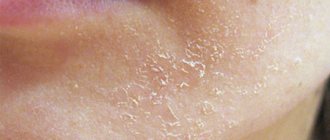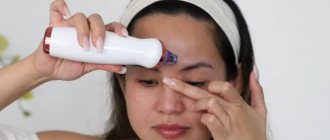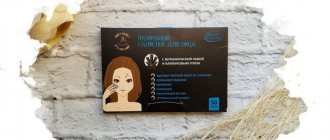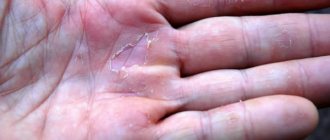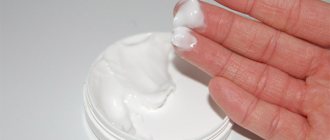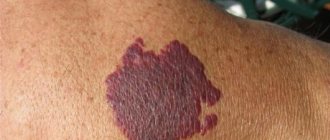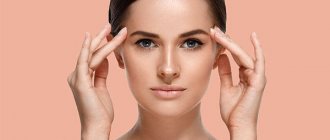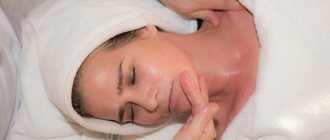Many representatives of the fair sex of all ages suffer from the fact that they have thin skin on their faces, which reacts with irritation and redness to everything. I allowed myself an extra glass of wine in the evening or forgot my sunglasses at home in the summer - and now the sensitive epidermis makes itself felt. You need to learn to live with this feature of your appearance and see not only the disadvantages in it. Among the advantages are aristocratic pallor and a similar structure to the skin around the eyes. So the care and corresponding recommendations will be approximately the same.
Signs of thin and sensitive skin
How to determine whether you have thin skin or not? Let's look at the main signs of thin skin. You have thin skin if:
- After you wash your face, your skin feels tight.
- There is often redness on the face, as well as itching and burning.
- The skin often peels.
- There are often negative reactions to cosmetics.
Important! If you are not sure, you can do a simple test. To do this, take a pen and run the blunt end across your cheek:
- If the pen mark disappears within 20 seconds, your skin is normal.
- If you stay for a longer period, it means you have thin and sensitive skin.
Recipe 5. Mask to combat oily shine
All you need to do is use milk instead of water to prepare the gelatin base. You can also use cream. The finished product is applied evenly to the face, after 20-30 minutes it can be removed.
If you wish, you can add 1 teaspoon of honey or the same amount of melted butter.
These ingredients will enhance the nutritional and moisturizing properties of the gelatin mask. After the first procedure, the skin will become smooth and soft.
Cosmetics
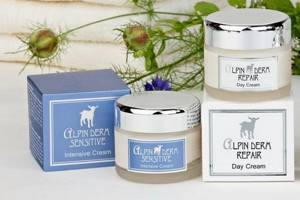
For thin and sensitive facial skin, look for products marked “Sensitive”
To care for such problematic, dried out epidermis, you need specially developed cosmetics. It perfectly moisturizes, restores firmness and elasticity, and protects against external aggression.
There is another way out - to purchase and use creams and serums for the face, which are required by the thin skin around the eyes, which is also devoid of fat and needs special, more careful treatment.
So buy products labeled “sensitive” or “for eyes”.
The approximate rating will help you choose something suitable for your budget:
- Bioregene crème peaux sensibles. Methode Cholley. Switzerland. $113.
- Super Sensitive Shield (Ultra Calming line). Dermalogica. USA. $90.
- 24-hour Care for sensitive. Biodroga. Germany. $71.
- Delicate Care Recovery Cream. Otome. Japan. $65.
- Idrasensitive 24-hour Cream. Eldan. Switzerland. $41.
- Bio Phyto Skin Balance. Christina. Israel. $37.
- Redermic C. La Roche-Posay. France. $36.
- Wildrose. Weleda. Germany. $19.
- Cream for sensitive skin. Bark. Russia. $9.
- Anti-Wrinkle. Olay. USA. $6.
All these cosmetic creams can be used not only for thin facial skin, but also for the equally sensitive and defenseless epidermis around the eyes. A magical transformation becomes possible thanks to the unique composition of such cosmetics. As a rule, it contains the following active substances:
- allantoin soothes irritations and restores damaged epidermis;
- hyaluronic acid moisturizes, heals;
- almond oil, myrrh, jojoba create a barrier film from aggressive external factors;
- retinol moisturizes, restores, prevents dryness;
- ascorbic acid heals, protects, strengthens, and maintains the fat (lipid) layer in a normal state;
- tocopherol gives elasticity, tones, rejuvenates;
- plant extracts have a healing effect.
Even the very thin skin under the eyes and the most sensitive epidermis of the face are transformed under the influence of properly selected cosmetics. The rays of facial wrinkles become less noticeable. The pallor recedes and a blush appears on the cheeks. Abundant hydration prevents dryness and flaking.
Skin moisturizing methods
Dry skin requires, first of all, sufficient hydration and protection from external irritants that can cause harm to it. Moisturizers for dry skin must include special substances - humectants (hydratants), which ensure a normal level of moisture. According to their mechanism of action, humectants are film-forming and hygroscopic.
Film-forming humectants include glycerin, waxes, mineral oils and fats. By forming a waterproof film on the surface of the skin, they help retain moisture in the skin and prevent its evaporation. Among the hydrants of this group, glycerin - a natural trihydric alcohol, hexahydric alcohol sorbitol and linolenic and linoleic acids - can be particularly distinguished.
Due to its ability to retain liquid, glycerin has been used in cosmetic formulations for many decades. Not long ago, American scientists discovered another property of glycerin - the ability to send a signal and stimulate the process of maturation of young skin cells. Cell renewal maintains normal moisture levels and prevents dry skin.
The hexahydric alcohol sorbitol, which belongs to the same group, also has hygroscopic properties. It moisturizes the skin and also significantly improves the texture of moisturizing creams, masks and other cosmetic products, giving them plasticity, softness and velvety. Linolenic acid can not only form a hydrophilic film on the surface of the skin, but also regulate the barrier permeability of the epidermis. Linoleic acid is necessary both for creating a waterproof lipid barrier and for regulating local skin immunity.
The group of hygroscopic humectants includes urea, hyaluronic, pyrrolidonecarboxylic and lactic acids, collagen. The molecules of these skin-related substances bind water and retain it in the skin. They are able to restore the level of natural moisturizing factor (NMF) in the epidermis. Among this group, hyaluronic acid has the highest hygroscopicity, one gram of which converts one liter of water into a gel-like state. The cosmetic industry uses hyaluronic acid extracted from cockscombs and shark skin.
Collagen (Greek - glue), present in the intercellular space and skin cells, is capable of absorbing and retaining an amount of water 30 times greater than its own weight. The cosmetic industry widely uses collagen's ability to absorb moisture.
When choosing moisturizers for dry skin, pay attention to their composition and the presence of the above listed ingredients. The best way to combat dry skin of the face and body is to develop an individual, comprehensive moisturizing program that includes nutritional and skin care tips, appropriate creams, masks and procedures. The problem of dry skin should be solved by dermatocosmetologists, taking into account the degree of skin dehydration, seasonality, age and other individual characteristics. Today this can be done to achieve good cosmetic results, prolonging the youth and health of the skin of the face and body.
Young, thin facial skin delights with its porcelain color, softness and velvety feel. With age, immune properties decrease, inflammation and irritation occur more often. For treatment and restoration, it is necessary to constantly protect the skin from the environment and low-quality cosmetics. An integrated approach and the use of home cosmetics will improve the condition of the dermis.
Factors that negatively affect thin skin
Since we are talking about caring for thin facial skin, we should also mention that some factors negatively affect its condition and it is advisable to exclude them:
- We have already mentioned that sensitive skin does not tolerate chlorinated water, so you should not provoke it into irritation and wash your face with tap water. But if you cannot avoid contact with this, for example, when visiting a swimming pool, then you need to apply a special water-repellent cream.
- This type of skin does not like frequent changes of cosmetics. Experts recommend changing products no more than once every 3 months.
- For those with thin skin, masks based on aloe, honey, as well as hormonal creams and ointments are contraindicated.
- Nicotine also has a negative effect. Therefore, try not to stay in a smoky room for a long time.
Video “Why is the skin dry and thin?”
Informational video that will help you understand the reasons why the epidermis is dry and thin.
One of the main skin types is dry skin.
– manifests itself as a feeling of tightness, peeling, finely porous structure, dull shade and easy irritation. If in youth dry facial skin looks thin, velvety and tender, then with age and without proper care its condition rapidly worsens and leads to the premature appearance of wrinkles and fading. Objectively, the phenomenon of dry skin is characterized by a violation of water and lipid metabolism, the functioning of the sweat and sebaceous glands, and a slightly acidic pH reaction (acid-base state). It is very easy to determine dry skin yourself: if, when pressing on the skin with your fingers, the marks do not disappear for a long time, it means that your skin is dry and this information is intended specifically for you.
The determining factor in the beauty, youth and health of the skin is the level of water balance in the body. Insufficient fluid intake from food can cause dry skin. To maintain normal skin moisture, cosmetologists advise drinking 1.5 to 2 liters of water per day. This volume of fluid consumed not only replenishes its natural losses, but also removes toxins and breakdown products from the body, which, in turn, affects the condition of the skin.
Dry skin, flaking and a feeling of tightness are the causes of early skin aging. Loss of skin elasticity leads to the formation of a fine network of fine wrinkles, which, in the absence of a sufficient level of skin hydration, quickly turn into deep grooves. First of all, wrinkles appear in the corners of the eyes and mouth, as well as on the neck - areas with the thinnest skin structure. Unfavorable climatic factors (wind, low humidity, sun rays, cold air, temperature changes) dry out the skin even more, depriving it of the necessary moisture and protection.
The development of dry skin can be caused by poor nutrition, deficiency of vitamins and minerals, diseases of the nervous system, and work in hot shops. All these factors trigger a whole chain of changes occurring in the skin. Reduced skin protective barriers cause moisture loss. In turn, this entails disruption of blood microcirculation processes in tissues and their trophism. As a result of insufficient nutrition, collagen fibers suffer, and the firmness and elasticity of the skin decreases. These skin changes are further aggravated by lack of proper care.
Dry skin can also be caused by the wrong choice of cosmetics and care products, as well as certain cosmetic procedures. If the sebaceous glands are not functioning properly, the use of soap for washing, alcohol lotions, exfoliating peels and scrubs, or tightening masks is contraindicated. Among cosmetic procedures, preference should be given to enzymatic peeling, which has the most delicate effect on the protective layer and intensively moisturizes dry skin.
Dry skin needs nourishing and fortified creams, nourishing and toning masks, non-alcoholic tonics, creams containing collagen and elastin. All these cosmetics will help restore the skin's natural protection. The cosmetics used should be designed specifically for dry skin and include an active skin moisturizing complex.
An important point in the fight against dry skin is nutritional correction: eliminating alcohol, enriching the diet with foods containing vitamins A, E, C.
Where is the threat hiding?
Of course, if the structure of skin tissue is determined genetically, it will not be possible to change the situation. But there are additional factors that can provoke or aggravate the problems of thin skin. By controlling the influence of these factors, you can maintain a healthy and attractive face.
Sun rays

Those with thin skin are strictly prohibited from being exposed to direct sunlight for a long time. With prolonged exposure, ultraviolet radiation destroys collagen and elastin in skin tissues, as a result of which they lose their elasticity and the face becomes covered with pigment spots. This provokes premature aging of the skin. In order to protect your face from negative consequences, before leaving the house, apply a special cream that has an SPF filter. If you are going to be under the sun for more than half an hour, the protection level of such a cream should be at least thirty units.
Deep peeling
For thin skin, peeling only causes harm. After removing the “extra” layers, many useful substances are consumed for restoration. Therefore, the skin becomes even thinner. As a consequence of such exposure, wrinkles appear and the sensitivity of dermal tissue to ultraviolet radiation and other irritants increases. What to do in such a situation? It is worth replacing the peeling procedure with gommage, its effects are much softer.
Creams for thin skin
LOreal Paris Trio Active Age expert Trio Active 35+ , the composition is rich in minerals and vitamins that can strengthen thin integuments, improve turgor and elasticity, restore the lipid layer, provides deep hydration and toning for 24 hours.
Night face cream Garnier Skin Naturals Youth Radiance 25+ , the active composition fights aggressive environmental factors, special plant cells of youth prevent aging, improve microcirculation, preventing the appearance of rosacea.
Day cream for dry and sensitive Black Pearl perfectly moisturizes and protects the thin epidermis thanks to a composition of vegetable oils, hyaluronic acid and vitamins. The complexion improves and the facial vessels are strengthened.
Peeling thin skin
For deep cleansing and removal of dead cells, for thin skin you should absolutely not use acid or hardware peeling. After such procedures, allergies and irritations will appear more often, wounds and cracks will form. You can use folk recipes.
The herbs of chamomile, plantain and mint, and kelp clean well and do not irritate the skin; the main thing is to grind it to the consistency of powder so as not to scratch the skin. Apply only to damp skin, without rubbing or stretching the tissue.
Home Recipes
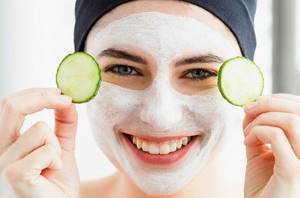
p, blockquote 28,0,0,0,0 —>
Very often, dry, thin facial skin that requires hydration reacts too violently to contact with any industrially produced formulas. And all that remains is to throw away or re-gift the purchased jars of creams and bottles of serums. But you shouldn’t give up in such a situation.
p, blockquote 29,0,0,0,0 —>
It is possible to restore the water balance of cells at home. Products such as cucumber, cosmetic oils, eggs, milk, avocado will help you. Make nourishing masks from them once a week - and feel the first results of home care.
p, blockquote 30,0,0,1,0 —>
- Mask with starch
Pour 30 grams of potato starch into 15 ml of heavy cream and leave for half an hour. Add 30 ml of vitamin E oil. Place the mixture in the refrigerator for 3 hours. Sprinkle with 10 grams of finely chopped mint and parsley. To stir thoroughly. An alternative to tocopherol is almond, burdock or olive oil.
p, blockquote 31,0,0,0,0 —>
- Cucumber mask
Beat 50 ml of cucumber juice with 1 egg white, 10 ml of almond oil, 1 ampoule of retinol, 10 ml of tocopherol. Bring to the desired consistency by sprinkling with a small amount of wheat flour (you can learn about the benefits of cucumber masks and other effective recipes from our article).
p, blockquote 32,0,0,0,0 —>
- Avocado mask
Mix 20 grams of pureed avocado pulp with 10 ml of olive oil.
p, blockquote 33,0,0,0,0 —>
- Spinach mask
Add an ampoule of retinol and 10 grams of fatty cream for sensitive, thin skin to 20 ml of spinach juice.
p, blockquote 34,0,0,0,0 —>
- Parsley mask
How to determine your type?
In order to understand what type of facial skin you have, it is not necessary to contact specialists, since determining it yourself is not at all difficult , you just need to follow the diagram:
- Cleansing: Cleanse your face of makeup and other foreign substances such as dust and grease in the usual way.
- Rest: Allow your face to rest for about two hours.
- Visual analysis: armed with a magnifying mirror and good lighting, for example, daylight, examine whether there is peeling, enlarged pores, or oily sheen on the surface of the skin.
- Blotting: blot your face with a clean, dry cloth and inspect it for the appearance of greasy stains.
A simple test on how to determine your skin type

How to avoid worsening the situation at different times of the year?
It's no secret that at different times of the year and in different weather conditions, human skin is exposed to external factors. In order not to aggravate the situation, you must adhere to certain rules that will help avoid additional inflammation.
In summer, for this purpose, sunscreen, foam or emulsion must be present in the daily care ritual.
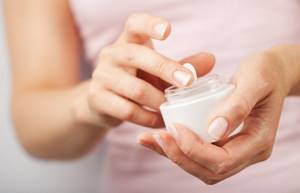
How to choose a remedy for dry hands? Read more
When exposed to sunlight, the skin can not only get burns, which will cause a lot of inconvenience, but can also dry out. This will lead to even greater thinning, as a result, without going to a dermatologist it will not be easy to correct the situation.
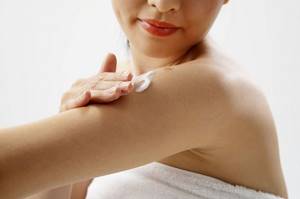
In summer, it is also recommended to cover the skin with thin fabrics, such as chiffon or tulle, so as not to expose it to the sun again. And on the beaches, use special tanning products; you can use a cheaper, but natural and effective product - olive oil.
In the winter season, when it comes to facial skin, you need to use protective creams against bad weather. You can also use any rich cream 10-15 minutes before going out into the cold. By covering the epidermis with an oily film, dry skin will be protected from wind, frost and exposure to cold weather.
Causes of dry skin on heels
Poorly chosen shoes are a common cause of dry skin on the heels. Inconvenient lasts, high heels, mismatched sizes - all this can cause roughness.
Insufficient care is another reason why the skin of the feet and heels dries out. Untimely pedicures and irregular use of nourishing creams lead to cracking of the skin on the feet and discomfort.
Fungal infections can also cause problems with dry, itchy, and cracked heels in men and women.
In diseases of the internal organs, dry heels often occur; the reason lies in metabolic disorders. Psoriasis, eczema, dermatitis, allergies, diabetes mellitus are the culprits that cause the skin to crack and peel.
Types of oily facial skin
Oily seborrheic skin is divided into two main subtypes and one subtype. They differ in the composition of sebum.
Liquid seborrhea . The composition of sebum is dominated by unsaturated fatty acids. The skin is greasy and shiny, like a buttered pancake. The pores are large, but shallow and empty. Fat flows freely from the pores without clogging them. There are no clogged pores or subcutaneous tissues on this type.
Thick seborrhea . The composition of sebum is dominated by saturated thick fatty acids. They tightly clog pores and create plugs, blackheads and subcutaneous areas. Comedones and inflammations of all kinds feel very comfortable on such skin and bloom in lush colors. The skin is thick and rough. Often it is matte and almost not greasy.
Mixed seborrhea . Particularly lucky people have mixed seborrhea. A greasy pancake, blackheads, subcutaneous skin and inflammation - all on one face.
What to do?
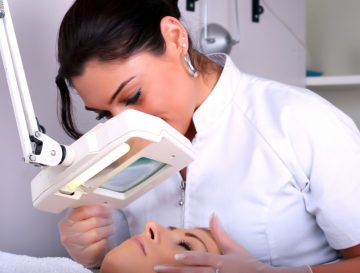
If the skin, in addition to oiliness, has serious problems in the form of inflammation, which does not go away after applying cosmetic methods, you should seek medical help from doctors such as:
- dermatologist;
- gastroenterologist;
- endocrinologist;
- gynecologist.
The challenges facing the owner of oily skin boil down to:
- cleansing it of excess sebum;
- opening clogged pores;
- reducing the active work of the sebaceous glands.
You need to get rid of cosmetics containing alcohol, creams with high fat content , you should not use a scrub often and do peeling.
Makeup should always be removed at night.
It is advisable to review your diet , remove harmful foods from there and enrich them with healthy ones: lean meat and fish, vegetables and fruits, cereals and bran, vitamins.
Direct care is divided into professional and home care.
Treatments in the salon
In beauty salons, they approach the issue comprehensively:
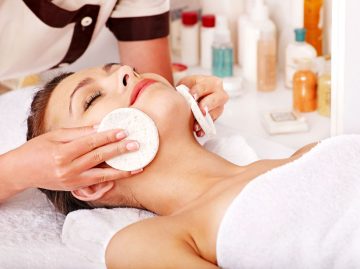
- remove makeup with special products;
- cleanse the skin and tone it;
- remove the top layer of dead keratinized particles;
- deeply cleanse in a suitable manner;
- apply serum;
- do therapeutic massage;
- apply a suitable cosmetic mask;
- apply finishing agent.
The duties of a cosmetologist include advising the client on proper daily self-care and giving recommendations on suitable cosmetics for care.
Home care
General rules for independent daily care for oily skin.
In the morning you need to do the following procedures:
- Wash with a special product using cool water. Foam or gel that matches the type will effectively cleanse the skin, and cool water will provide it with tone.
Did you know?
Soap is not recommended for washing - it is too drying. You can wash your face with a decoction of oatmeal (without salt and sugar!), whey or yogurt.
- Rubbing with a tonic , which has a soothing effect and prepares the skin for makeup. Instead of tonic, you can use decoctions of medicinal herbs; they are especially good in the form of a frozen ice cube, which is used to wipe your face.
- Applying the base. The base cream, selected according to type, has few fatty components and contains oils.
- At this stage, the inflamed areas are treated with a drying agent , applying it in a targeted manner.
- Application of products that can protect against ultraviolet radiation. This is the final product applied on top of the finished makeup.
Important!
It is very important to protect your face from ultraviolet radiation, because it leads to premature aging. A filter marked SPF10 allows you to stay in the sun for three hours, SPF20 is suitable for residents of the middle zone; in the hot south there is no point in using products with a filter lower than SPF30.

In the evening you need a face:
- clean off makeup or what’s left of it;
- Apply night cream or other product suitable for the occasion and skin type; it is good if it contains vitamins.
During the day :
- Remove excess fat with special wipes that will not spoil makeup.
- Scrub the skin , deeply cleansing it of dead particles and opening the pores. The composition of the product may include particles of raspberry or apricot seeds, pine nut shells, and so on. The procedure should be performed with caution, trying not to scratch the top layer of the epidermis, and no more than three days after the previous peeling. It is better to do this shortly before bedtime, when there is no need to go anywhere.
- Masks made by hand or purchased on sale are applied to the face
Popular means
The cosmetics industry produces a wide range of products designed to care for oily skin.
Experts recommend using a line from the same series , explaining that in this case the components of the drugs will not conflict with each other. Perhaps marketing plays a big role, but in any case it is convenient.

It is advisable to first purchase one product from the series, for example, a cleansing gel or tonic, test its effect on yourself, and if the skin has acquired a healthier appearance and there are no unwanted reactions, purchase the entire line or part of it.
Once every three months (conveniently divided by season), it is recommended to change the series of products and their manufacturer. Each company has its own technologies that have different effects on the skin, and periodically changing the brand will give a good result.
Important!
If you do not have your own experience, it is better to choose cosmetics at first on the advice of a specialist.
Decorative cosmetics are selected taking into account quality, composition and recommendations . Oily skin will benefit from a light foundation, powder or foundation that has a mattifying effect and eliminates unwanted shine.
To prevent cosmetics from “floating”, it is better not to use liquid eyeliners, cream blush and shadows at all.
Masks for oily skin
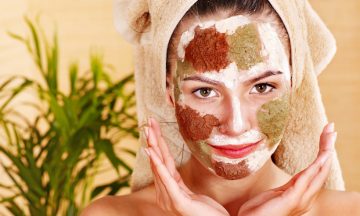
Oily skin requires nutrition no less than other types, only its “diet” is different. At home, it is not difficult to make one of these masks, which should be left on the face for a quarter of an hour and then washed off with warm water:
- Mix low-fat cream and lemon juice in equal proportions, for example, 2 tablespoons each.
- Mix crushed raspberries and rice flour in equal proportions, but so that the mass is thick and homogeneous.
- Mix the beaten white of one egg with 3 tablespoons of ground rolled oats.
- Mix in a container a tablespoon of kaolin and a tablespoon of corn flour, one egg white, half a teaspoon of alcohol and the same amount of lemon juice.
- Mix two teaspoons of yogurt, the same amount of honey, half a teaspoon of lemon juice.
- Beat the egg white with half a teaspoon of lemon juice.
- Brew a tablespoon of calendula leaves in 100 grams of boiling water, wait until the broth becomes warm, soak a towel in it, and apply it to your face for 15 minutes.
Recommendations for sensitive skin
In addition to daily care for thin skin, you need to follow the following recommendations:
- Do not use regular soap, use a special gel or milk for washing.
- Don't leave makeup on overnight.
- Use creams and make masks regularly.
Important! The main trick in this matter is properly selected skin care products. And we will help you figure this out:
- If you make masks, remember that they should not contain alcohol or aggressive components, such as mustard.
Important! It is advisable to test any mask for allergies.
- Often, problems with the skin are caused by vitamin deficiency, in particular a lack of B vitamins. Therefore, your best friends should be fruits, vegetables, nuts, and bran. You should exclude spicy, fried, and salty foods from your diet.
- You should not use cosmetic ice or herbal compresses; aromatherapy is also contraindicated for you.
- Do not overuse the sauna or bath procedures, limit your time in the sun.
- Your best assistant is sleep. During sleep, cells are renewed and restored.
- Try to control your facial expressions - don’t squint your eyes, don’t wrinkle your forehead.
- Drink more water. Remember, a person should drink at least 1.5 liters of water a day, and in your case, 2 is better.
- Try to protect your face from direct rays of the sun, use special sunscreens.
- For peeling, choose products with artificial exfoliating microgranules, which are less damaging to the skin.
The most effective natural homemade masks for skin tightening, renewal and nutrition
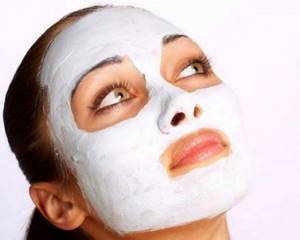
Masks will bring the long-awaited effect only with regular use
Very often, thin and dry skin reacts negatively to factory-made cosmetics with the appearance of irritation, redness and swelling. For those with sensitive skin, we recommend preparing the following simple masks from available ingredients 3 times a week, preferably in the evening.
Do not forget that masks will bring the long-awaited effect only with regular use, as well as if they are applied to clean skin, free of cosmetics and impurities.
- Based on cucumber juice. You will need to mix 50 ml of juice from fresh, finely grated cucumber with egg yolk, 10 ml of almond oil, 1 ampoule of retinol - vitamin A and 1 ampoule of vitamin E (sold at the pharmacy). Add wheat flour to the consistency of sour cream, mixing everything thoroughly.
- Based on parsley juice. You will need 20 ml of olive oil, 10 grams of potato flour and parsley chopped in a blender. Mix all ingredients well and apply.
- Avocado based. Avocado pulp, converted into a mushy mass in the amount of 20 grams, is mixed with 10 ml of cold-pressed olive oil, everything is mixed well.
- Spinach based mask. Take 20 ml of fresh spinach juice, add 1 ampoule of vitamin A and 10 grams of baby fat cream to it, mix everything thoroughly and apply.
- Starch based. Potato starch in an amount of 30 grams is mixed with 15 ml of high-fat cream, and the mixture is left for 30 minutes. Then add 30 ml of vitamin E oil pharmaceutical concentrate (in ampoules) to the composition and leave the mass in the refrigerator for 3 hours. Before use, add 10 grams of finely chopped mint and parsley and mix thoroughly.
Don't forget that a varied diet, good sleep, a healthy lifestyle, and giving up bad habits can have a positive effect on the condition of your skin!
By receiving constant care with cleansing, moisturizing, nourishing and protecting, your skin will be filled with radiance, health and elasticity so that you always remain young, beautiful and desirable!
Effective cosmetics and useful procedures
To ensure that thin skin brings as little trouble as possible, and that caring for it does not take much time, you should learn to choose the right cosmetics. It doesn’t hurt to carry out salon or home care treatments from time to time.
How to choose the right cosmetics?
First of all, you should carefully read the ingredients on the label. For thin skin, cosmetics that contain at least one of the following ingredients will be useful:
- allantoin (works for rapid regeneration of the facial surface);
- tocopherol (prevents dehydration and early skin aging);
- hyaluronic acid (nourishes and moisturizes cells);
- retinol (this is vitamin A in liquid form, which makes the dermis elastic);
- ascorbic acid (vitamin C prevents the appearance of rashes and redness);
- oils and plant extracts (nourish the skin, reduce dryness and flaking).
Products with the maximum amount of natural ingredients in the composition, without parabens and other harmful substances, have the best effect on thin skin.
Useful salon treatments
If finances and time allow, full-fledged care for thin skin can be carried out in a cosmetologist’s office:
- phototherapy (IPL) removes veins and spider veins on the face.
The process follows a simple scheme: a cosmetologist uses a special device to apply it over the entire surface of a previously cleaned face, and then fixes the result with a nourishing composition. The procedure is virtually painless, effective and has few side effects.
- biorevitalization replenishes the required amount of moisture in the epidermis.
The procedure rejuvenates the skin, gives an anti-inflammatory effect and strengthens blood vessels. The process is very painful - a solution of hyaluronic acid is injected into small syringes, and then, through a needle, the medicine is sent into the deep layers of the skin. Within 1-2 days, small marks from the injections remain on the face, but after they disappear, the effect is amazing - the skin is firmer, moisturized and looks healthy.
- microcurrent therapy enhances the immunity of the dermis.
In the process, the cosmetologist directs barely noticeable current discharges to the face with a special device, and then applies a special medicinal composition to the skin. The procedure is painless and especially effective for sagging skin.
Procedures at home
Thin skin requires constant care, which can be easily organized at home. It can be:
- natural masks;
- compresses.
The most effective masks are made from ingredients that can be easily found at any housewife.
- Mask with starch.
Mix 30-40 g of potato starch with two teaspoons of cream, let it brew for 30 minutes. Then add vitamin E in the form of oil, put the mixture in the refrigerator for 2.5-3 hours. Store the mask for no more than 3 days, apply daily for 30-40 minutes.
- Cucumber juice mask.
Mix 50 ml of juice with 1 egg white, add a teaspoon of almond oil and 10 ml of retinol or tocopherol, and then sprinkle the mixture with flour. The composition cannot be stored for a long time. Apply the mask once every three days for 30 minutes.
- Light mask with avocado.
Peel the avocado and puree it by hand or in a blender. Add 10 ml olive oil (extra virgin). Store the mask in the refrigerator for no more than 3 days. It can be applied to the face daily for 20-25 minutes.
- Mask made of flour and parsley.
Dilute 10 grams of flour (preferably potato flour) with 20 ml of olive oil. The composition is designed for one use; it is better not to store it even in the refrigerator. Keep on face for no more than 20 minutes.
A compress made from cornflower blue flowers is also considered effective. To prepare the solution, mix at least 20 grams of dried flowers with 100 ml of heated vegetable oil (almond or olive). A fabric mask is soaked in the mixture and applied to the face for 20 minutes.
Care for thin skin
Thin-textured skin is characterized by dryness and frequent irritation. It has one significant drawback, which is almost impossible to eliminate - it is more quickly subject to aging and the appearance of wrinkles. Unlike other types of epidermis, it is less resistant to external factors and weather conditions, and therefore most often has a dull, fading appearance.
However, the problems described above can be counteracted if you properly care for this type of epidermis. And the first thing you should pay attention to is hygiene. This applies not only to the dermis on the body, but also to the face. When skin comes into contact with water, irritation may occur, leading to peeling, inflammation and redness. To avoid this, it is recommended to use:
- warm water at room temperature, you can use slightly cool water, but in no case hot;
- it is better to use boiled or melt water, as it has a more gentle effect on the epidermis than chlorinated water;
- You can use herbal decoctions instead of water; chamomile, string, St. John's wort, and nettle are best for this.
When to see a doctor
There is usually no need to see a doctor for an examination of thin skin caused by aging and not presenting any health problems. If a person finds that they frequently bruise or break their skin, they may seek medical help.
Some medications can cause thinning of the skin. Your doctor can advise whether you should stop using the drug and suggest possible alternatives.
If thinning skin does not have an obvious cause, you may want to seek medical help. It may be lifestyle factors such as sun exposure or smoking that have led to thinning skin.
Special treatment is not available for thin skin, so prevention is the best option. Protecting your skin from sunlight and keeping it hydrated can help prevent further skin thinning.
We've selected related products based on product quality and listed the pros and cons of each to help you determine which ones will work best for you. We have partnerships with some of the companies who sell these products, which means Healthline UK and our partners may receive a share of the revenue if you make a purchase through the link(s) above.
How to thicken the skin on the face and under the eyes: proper care and strengthening
What to do if your skin is naturally thin and sensitive? How to preserve its beauty and attractiveness for many years? How to strengthen such skin, make it thicker and denser, and therefore younger and more elastic? All these pressing issues will be covered, be careful and remember!
What information will you find out:
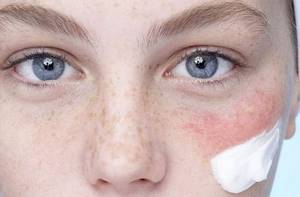
Sensitive and thin skin
With age, our skin type can change depending on lifestyle, climate, bad habits, dietary habits, professional conditions, cosmetics used, and past diseases.
Thin facial skin can be easily tested using a regular napkin. When you apply it to your face, you will never see traces of oil, since this type is prone to excessive dryness. This condition is caused by a decrease or complete absence of sebum production. It leads to loss of elasticity, firmness, premature aging and the appearance of a noticeable number of wrinkles. In addition, this type of skin is characterized by pronounced capillaries, which can give the face a red and unhealthy tint due to the thinness of the epidermis.
As for the skin around the eyes, in all women, without exception, it is dry and thin due to the lack of subcutaneous fatty tissue. If you start proper care from an early age, you will maintain and also significantly improve its condition for many years without the need to use radical and aggressive rejuvenation techniques.
Thin skin on the face, veins are visible. The essence of pathology
Cuperosis (rosacea of an unspecified type) thus refers to pathologies with impaired blood microcirculation due to increased fragility and dilation of capillaries. This happens due to a violation of the elasticity of the blood vessels, and their wear resistance is lost. Negative factors can narrow and expand capillaries. But the property of narrowing is quickly lost and vasodilation remains. They do not have time to pump blood. This is often accompanied by blockage. It looks like red dots with convoluted lines of capillaries extending from them. Their thickness does not exceed 1 mm, the color is red and violet-red.
Stars are a very precise name for formations on non-inflamed skin. They are especially often and clearly visible on the cheeks and wings of the nose. More often, this pathology is typical for women, especially after 30 years. They pay more attention to their appearance, perhaps this explains the frequency.
What should the diet consist of?
Almost every dermatologist recommends reviewing your diet and adding the most suitable foods. To do this, daily meals must include fish and meat products. It is best to boil fish, as fried fish can promote the formation of inflammation, small pimples and cause clogged pores. And indeed, it is better for people with a specific type of epidermis to avoid this kind of junk food.
It is also better to steam or boil meat, without using hot spices. The daily diet of people with thin skin must include dairy products:
- yoghurts;
- milk;
- kefir;
- Ryazhenka
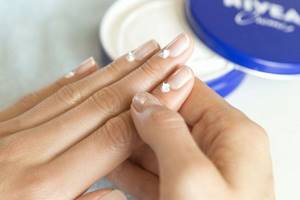
This will strengthen the body as a whole and help remove negative bacteria from the intestines. Don't forget about vitamins. Every day you need to eat 1-2 apples, which are rich in vitamins and other microelements.
Fat type: characteristics
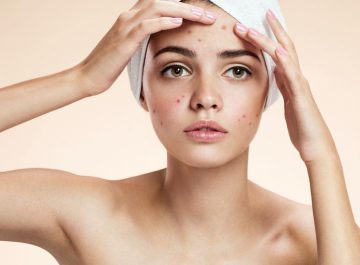
If you have oily facial skin, this means that you will have to do a little more for it than those with other types do, because it has more reasons for the appearance of all sorts of dermatological problems, and it has a specific appearance. She will need daily hygiene and regular professional care.
The favorite area of oily skin is the T-zone, that is, the skin of the forehead, nose and chin. It is different:
- shiny appearance;
- oily shine;
- external untidiness;
- rudeness;
- lack of smoothness;
- dull grayish tint.
It can be difficult to apply makeup on oily skin; sebum soon appears through any cosmetics, and blackheads on the nose treacherously appear even through a thick layer of camouflage cosmetics.
Did you know?
It rarely happens that oily skin is present only on the face; a more common situation is that the skin of the back and chest is also prone to oiliness, and the hair can quickly become greasy due to increased oiliness of the scalp.
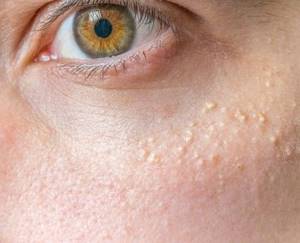
In the absence of proper care, excess fat, on which dust and exfoliated scales of the upper layer of the epidermis settle, form a substance that clogs the pores on the face and expands them. This face evokes associations with an orange, which has a similar peel structure.
In addition to aesthetic defects, such blockage is fraught with acne, the formation of blackheads (comedones) and whiteheads (milia). Vascular networks may form.
Recipe 1. Mask to tighten pores
You will need 1 egg and freshly squeezed juice from half a lemon. You need to beat the egg white separately and add a few tablespoons of juice. The resulting composition must be divided into two parts.
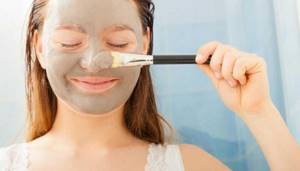
The skin of the face must first be cleaned and traces of cosmetics removed. To begin with, it is recommended to apply one part to the face, wait until it hardens, then apply the second part.
After 15 minutes, the mask can be washed off with cool water. Upon completion of the procedure, it is recommended to apply a moisturizer with a light structure.
Important! If you have combination skin, then apply a mask to narrow pores only on the T-zone.
